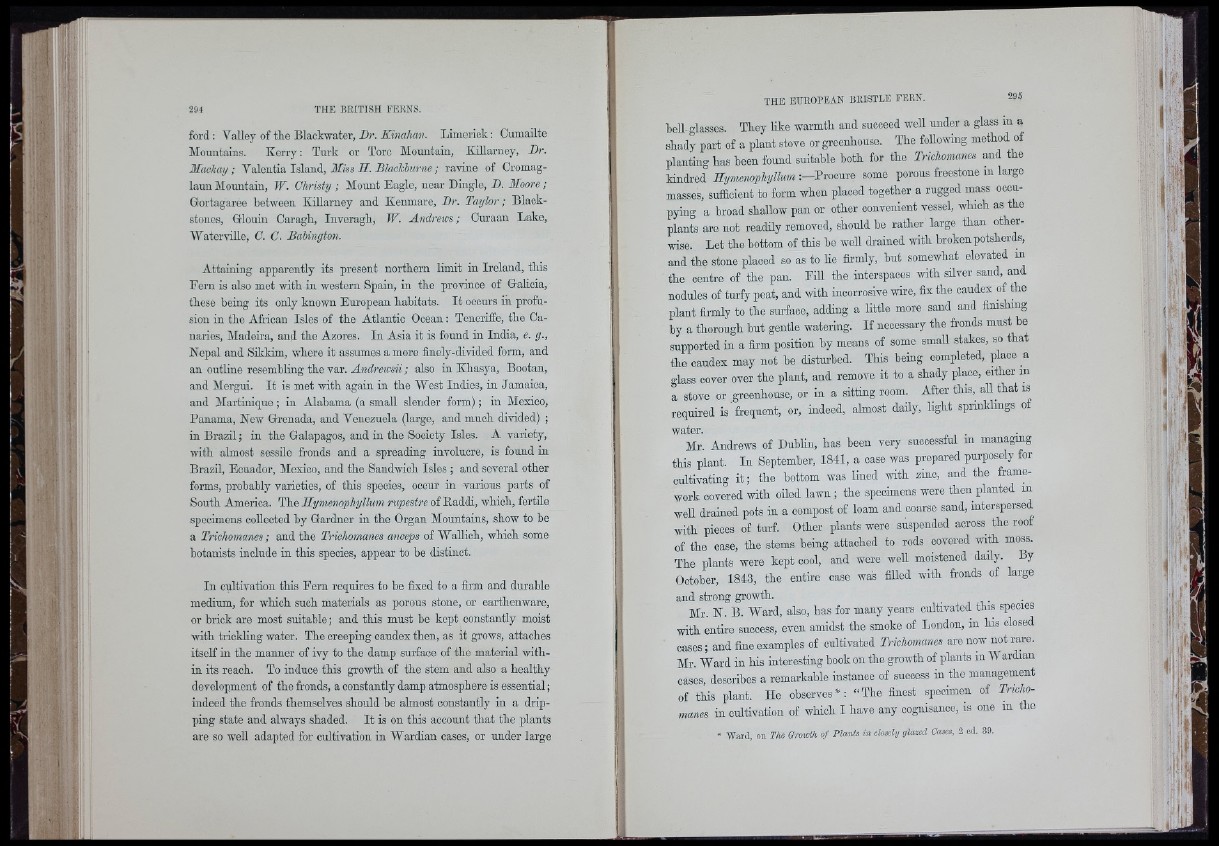
ford : Valley of the Blackwater, Br. Kinahan. Limerick: Cumailte
Mountains. Kerry: Turk or Toro Mountain, KUlarney, Br.
Mackay; Valentía Island, Mss J/. üfec/iJwrwe ; ravine of Cromag-
lauu Mountain, W. Christy ; Mount Eagle, near Dingle, B. Moore ;
Gortagaree between Killarney and Kenmarc, Br. Taylor; Blaok-
stones, Glouin Caragh, Inveragh, W. Andrews; Curaan Lake,
WaterviUe, C. C. Bahington.
Attaining apparently its present northern limit in Ireland, this
Fern is also met with in western Spain, in the province of Gahoia,
these hoing its only known European habitats. It occurs in prolusion
in tho African Isles of the Atlantic Ocean : Tenoriffe, the Canaries,
Madeira, and the Azores. In Asia it is found in India, e. g.,
Nepal and Sikkim, where it assumes a more finely-divided form, and
an outline resembling tho var. A«(frai'Sîï ; also in Khasya, Bootan,
and Morgui. It is met with again in the West Indies, in Jamaica,
and Martinique ; in Alabama (a small slender form) ; in Mexico,
Panama, New Grenada, aud Venezuela (large, and mueh divided) ;
in Brazil ; in the Galapagos, and in the Society Isles. A variety,
with almost sessile fronds and a spreading involucre, is found in
Brazil, Ecuador, Mexico, and the Sandwich Isles ; and several other
forms, probably varieties, of this species, occur in various parts of
South America. The Hymenophyllum rupestre of Eaddi, which, fertile
specimens ooHeoted by Gardner in the Organ Mountains, show to be
a Trichomanes ; and the Trichomanes anceps of Wallieh, which some
botanists include in this species, appear to be distinot.
In cultivation this Fern requires to be fixed to a firm and durable
medium, for which such materials as porous stone, or earthenware,
or brick are most suitable; and this must be kept constantly moist
with trickling water. The creeping caudex then, as it grows, attaches
itself in the manner of ivy to the damp surface of the material within
its reach. To induce this growth of the stem and also a healthy
development of the fronds, a constantly damp atmosphere is essential ;
indeed the fronds themselves should he almost constantly in a dripping
state and always shaded. It is on this aooount that the plants
are so well adapted for cultivation in Wardian eases, or under large
bell-glasses. They like warmth and succeed wcU under a glass m a
shady part of a plant stove or greenhouse. The following method of
planting has been found suitable both for the Trichomanes and the
kindred Hymenophyllum :—Procure some porous freostouo m largo
masses, sufficient to form when placed together a rugged mass occupying
a broad shallow pan or other convenient vessel, which as the
plants are not readily removed, should be rather large than otherwise.
Let the bottom of this be well drained with broken potsherds,
and the stone placed so as to he firmly, but somewhat elevated in
the centre of the pan. Fill the interspaces with silver sand, and
nodules of turfy peat, and with inoorrosive wire, fix the oaudox of tee
plant firmly to the surface, adding a little more sand and fimshing
by a thorough but gentle watering. If necessary the fronds must be
supported iu a firm position hy means of some small stakes, so teat
tee caudex may not he disturbed. This heing completed, place a
glass cover over the plant, and remove it to a shady place, either in
a stove or greenhouse, or in a sitting room. After this, all teat is
required is frequent, or, indeed, almost daily, light sprinklings oi
water.
Mr. Andrews of Dublin, has been very successful m managmg
tHs plant. In September, 1841, a case was prepared purposely for
cultivating it; tee bottom was lined with zinc, aud tee framework
covered with oiled lawn ; tee specimens were then planted in
well drained pots in a compost of loam and coarse sand, intersperse
with pieces of turf. Other plants were suspended across tho roof
of the case, tee stems being attached to rods revered wite moss.
Tho plants were kept cool, and wore well moistened daily. By
October, 1843, the entire case was filled with fronds of large
and strong growth.
Mr. N. B. Ward, also, has for many years cultivated this species
wite entire success, even amidst the smoke of London, in his closed
oases; and fine examples of cultivated Trichomanes are now not rare.
Mr. Ward in his interesting book on the growth of plants in Wardian
cases, describes a remarkable instance of success in the management
of tHs plant. He observes*: “The finest speoimon of Trichomanes
H cHtivation of which I have any cognisance, is oue in tec
* Ward, on The Growth o f Plants in closdij glazed Cases, 2 ed. 39.
i- fl
(
Y :
Jli.